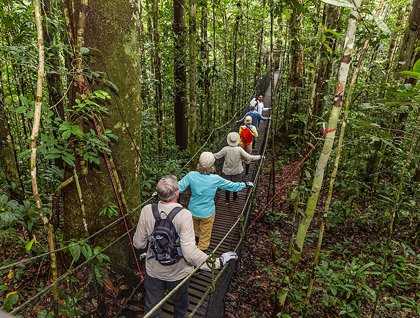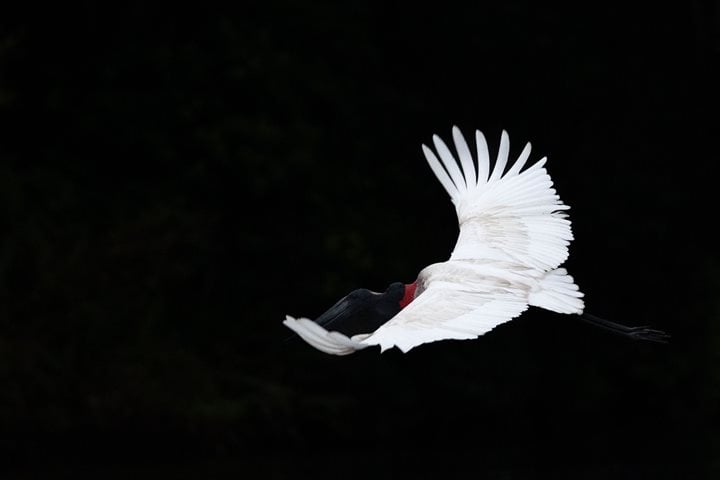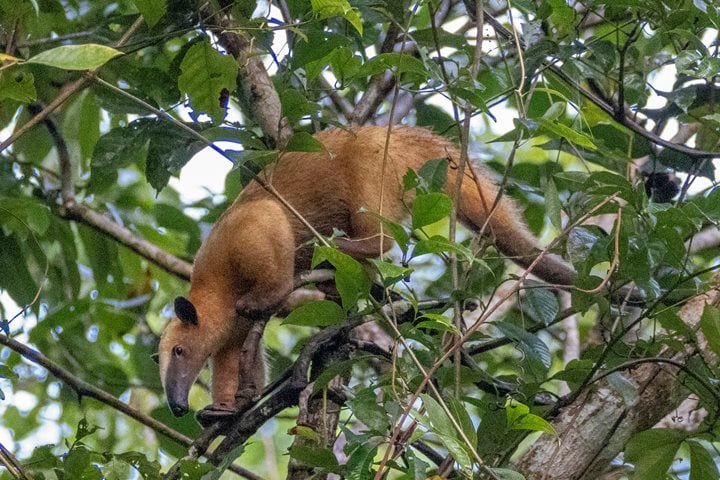Sunrise found the Delfin II with her bow pushed deeply into the Marañon riverbank, with a stout line tied to a nearby tree as a security measure, in case the current tried to float the ship off the bank. This is the way we commonly “anchor” at night, tied to the shore rather than anchoring on the river bottom itself. This also allows us the joy of waking up to the sounds of the rain forest as both we and the animals begin our day.
After breakfast, we had the privilege of visiting the primary growth forest of Amazon National Park. After a short “catamaran” (two canoes lashed together) trip across a small lagoon, we began a roughly 2.4 mile hike through the thick rain forest. With literally hundreds of thousands of species of animals all around us, it is surprising to many of us just how hard it is to find them! Luckily for us, our guides are each native to this area, and have decades of experience in spotting wildlife to draw our attention to.
Highlights of the morning treasure hunt included a black-collared tree runner, and a fairly large lizard, which blended almost perfectly into the tree it was perched on. Butterflies and moths in a huge assortment of colors and shapes flitted amongst the foliage. Insects too numerous to even begin to imagine (remember that there are about 2.5 million here in the Amazon Basin) were also seen and photographed.
The highlight of the morning for most of us was the opportunity to walk across a suspension rope bridge. This almost quarter-mile long bridge spans the mid-canopy of the rain forest, affording views that otherwise would only be available to those dexterous enough, or those able to ignore ant and other insect bites, as they scaled the tallest trees around! Without even having to get a bite or scratch, the bridge became our platform to look both down, up, and out into the forest that enveloped us. Beautiful!
After lunch, Captain Antonio repositioned the ship next to the outflow of a very small stream, known locally as a Nauta Caño, where black water from the stream meets the brown water from the Marañon River. These confluences of the tannin-rich black water and the silt-laden brown water are often the very best locations to find both species of river dolphin that live here. Today the diminutive gray river dolphin, locally known as bufeo grís, entertained us for literally hours as we waited out the heat of the day by trying to photograph these fast moving cetaceans from the deck of the ship. The staccato sound of dolphin blows was punctuated by an occasional terse explicative of frustrated photographers trying to capture that perfect millisecond of action. In the end, the dolphins got the better of the bargain!
Our late afternoon activity involved either a kayak or skiff exploration further into the black water of Nauta Caño. Many tens of species of birds were encountered, including a close-up look at the tiny American pygmy kingfisher. Not to be out-photographed, a ringed kingfisher dove right into the caño ahead of us, and popped out of the water with a piranha in its bill! Watching perhaps one of the master ambush predatory birds, the striated heron, stalk and then strike a small fish from its perch near water level was a reminder of how transient life really is.
We had one more small surprise to round out an already full day, when we grabbed flashlights after dinner and headed out for a walk at night in the rain forest. Katydids and cicadas serenaded us as we probed the dark forest with our beams of light. A small scorpion posed ever so briefly for a photograph, then on to a pink-footed tarantula, which seemed undaunted by the bright lights. Six different frog species were spotted, along with one small lizard lying dormant on a leaf. Spiders, stick insects, and a beautiful black-and-white zebra striped caterpillar all came under intense scrutiny. We returned to the Delfin II hot but happy, having had just a glimpse of the forest at night.







